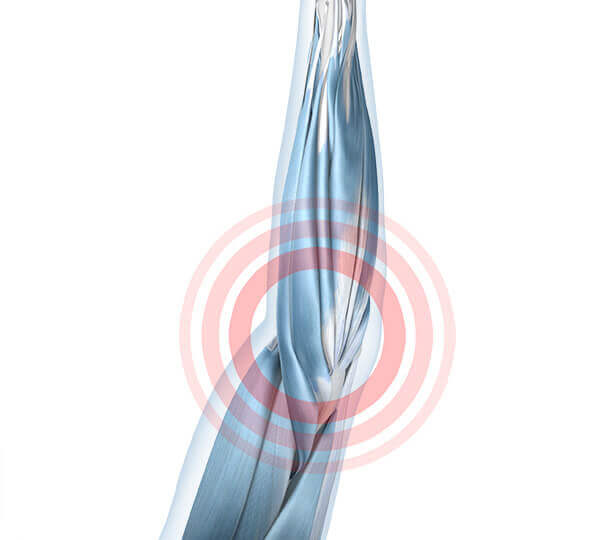
Tendon attachment site irritation
When tendons are subjected to excessive strain
Tendon attachment site irritation can occur in many different areas of the body. It often affects the elbow, with the irritation generally being triggered by repetitive everyday strain or excessive sporting activities. The symptoms, also known as tennis elbow and golfer’s elbow, usually subside completely if it is treated as early as possible. However, if tendon attachment site irritation remains undetected – and above all, untreated – there is a risk of developing secondary damage.
How does tendon attachment site irritation on the elbow develop?

The elbow is surrounded by muscles that start on the humerus and extend over the elbow joint, and to some degree the wrist. They are divided into flexor muscles, which are on the inside of the elbow, and extensor muscles, which are on the outside. There, they are connected to bony protrusions (epicondyles), which can be found on the elbow end of the humerus. When the muscles are flexed, it creates tension at the point where the muscles are inserted at the bone. Initially, this is harmless. However, if the same repetitive movements are constantly carried out over a long period of time, such as when using a mouse or keyboard, it can lead to problems. Constantly lifting heavy loads, using bulky tools on a daily basis, plastering or exercise are some of the most common causes of tendon attachment site irritation. This leads to minute injuries to the muscle insertions on the elbow, known as microtraumas. In most cases, these go unnoticed. Pain only occurs if inflammation develops over time. Symptoms are generally localized as well as reversible.
However, if the activities triggering the pain are not stopped and the condition is not treated, the problem continues to progress. The result is full-blown golfer’s elbow or tennis elbow, which can become chronic. This results in pain occurring more frequently and even when under less strain. Inflammation causes scars to form on the connective tissue and calcium deposits to develop on the muscle insertion. These consequences are no longer reversible. In the later stages, the irritated tendon can become so badly damaged that it ruptures.

How does tendon attachment site irritation manifest itself?
One of the common symptoms of tendon attachment site irritation is localized pain, which occurs when bending (golfer’s elbow) or stretching (tennis elbow) the wrist against resistance. Tense muscles or swelling of the tendon attachment are often palpable then, and inflammation can also lead to the build-up of heat and redness of the skin in the affected area. The muscle insertions on the inner and outer elbow may also hurt when subjected to pressure. If the condition progresses, normal use of the arm becomes impossible.
Treatment for tendon attachment site irritation – relieving strain and combating inflammation

The basic principles for treating golfer’s elbow and tennis elbow are the same: the focus is on relieving tension on the tendon insertion and fighting inflammation. There is a multitude of treatment options to do this, in which initially the activity triggering the pain must be stopped in order for the acute pain to subside. Complete immobilization of the arm is not necessary in most cases. Compressive orthoses and supports are often used as well. Anti-inflammatory or pain-relieving ointments or pills also encourage pain and swelling to subside. Physiotherapy treatment can begin as early as the acute stage, and this, too, aims to relieve tension and combat inflammation. Some examples of how this can be achieved include:
A direct injection of cortisone to fight inflammation is only used in exceptional cases, as the substance can cause further damage to the tendon. Instead, injecting botulinum toxin (botox) into the affected muscles has recently proven effective. This results in temporary paralysis of the treated muscles, effectively relieving the tendon attachments, which in turn leads to a rapid improvement of symptoms. It should, however, be noted that despite this, botox is a neurotoxin and should not be used too frequently.
Surgery is only considered if
The two most commonly used surgical procedures are tenotomy (transverse or longitudinal partial division of the tendon) or denervation (sclerotherapy of the nerves in the affected area). The two procedures can also be combined.
Relief using orthoses and supports for tendon attachment site irritation on the elbow

Orthoses and supports such as the EpiTrain were developed to support the treatment of tendon attachment site irritation as effectively as possible. The EpiTrain support does not limit freedom of movement and provides affected muscle insertions with controlled compression. This compression encourages muscles to relax and decreases muscle traction in the irritated area, thus relieving the typical pain symptoms. At the same time, it helps to reduce soft tissue swelling (edema) caused by inflammation, and therefore relieves nerves and blood vessels. The specially designed knitted compression fabric used for the EpiTrain also guarantees a perfect fit and a high degree of wearing comfort. Particularly skin-friendly, breathable materials allow for ideal ventilation and prevent heat build-up in the painful area. That is how, combined with the other treatment measures, the EpiTrain active support effectively encourages the healing process.
EpiTrain®
Elbow support for pain relief
EpiTrain alleviates pain in the elbow and improves its mobility. The effective knitted fabric and specially contoured pads provide relief and make it possible to start mobility training at an early stage.
To product page


